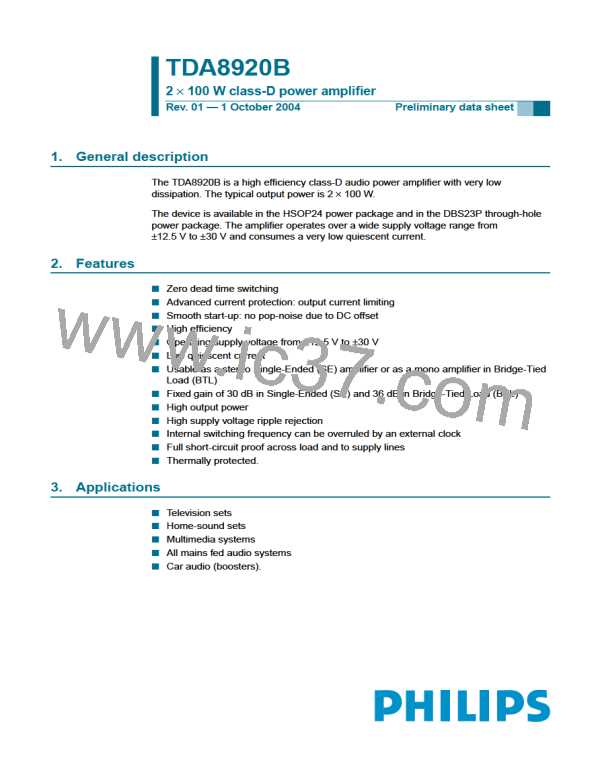TDA8920B
Philips Semiconductors
2 × 100 W class-D power amplifier
001aab233
001aab234
0
0
α
α
cs
cs
(dB)
−20
(dB)
−20
−40
−40
−60
−60
(1)
(2)
(1)
(2)
−80
−80
−100
−100
2
3
4
5
2
3
4
5
10
10
10
10
10
10
10
10
10
10
f (Hz)
f (Hz)
Vp = ±27 V; 2 × 3 Ω SE configuration.
(1) Pout = 10 W.
(2) Pout = 1 W.
Vp = ±27 V; 2 × 4 Ω SE configuration.
(1) Pout = 10 W.
(2) Pout = 1 W.
Fig 18. Channel separation as a function of frequency;
Fig 19. Channel separation as a function of frequency;
SE configuration with 2 × 3 Ω load.
SE configuration with 2 × 4 Ω load.
001aab235
001aab236
32
100
(3)
(2)
(4)
(1)
(3)
η
(%)
P
diss
(W)
80
24
(1)
60
40
20
0
(4)
16
8
(2)
0
10
−2
−1
2
3
10
1
10
10
10
(W)
0
80
160
240
P
P
(W)
o
o
Vp = ±27 V; f = 1 kHz.
Vp = ±27 V; f = 1 kHz.
(1) 2 × 3 Ω SE configuration.
(2) 2 × 4 Ω SE configuration.
(3) 1 × 6 Ω BTL configuration.
(4) 1 × 8 Ω BTL configuration.
(1) 2 × 3 Ω SE configuration.
(2) 2 × 4 Ω SE configuration.
(3) 1 × 6 Ω BTL configuration.
(4) 1 × 8 Ω BTL configuration.
Fig 20. Power dissipation as a function of total output
power.
Fig 21. Efficiency as a function of total output power.
9397 750 13356
© Koninklijke Philips Electronics N.V. 2004. All rights reserved.
Preliminary data sheet
Rev. 01 — 1 October 2004
24 of 34

 NXP [ NXP ]
NXP [ NXP ]